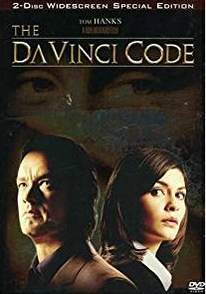Good ideas that read better than they film
 This isn’t to put down the fine cast and expression of sublime ideas that cause everyone to catch their breath the first time they hear them. It’s just the nature of the ideas.
This isn’t to put down the fine cast and expression of sublime ideas that cause everyone to catch their breath the first time they hear them. It’s just the nature of the ideas.
For those of you who were not swept up in The Da Vinci Code book, it was quite the page turner: An author and scholar specializing in cultural symbols, Dr. Langdon, visits Paris, France, to deliver a series of lectures. As he is finishing one of them, a police inspector (Fache) approaches him and insists Langdon accompany him to the Louvre.
There the curator (Saunière) has seemingly been killed or committed suicide in a bizarre fashion, leaving clues in his blood stains and body position specifically for Dr. Langdon to decipher. This seems evidence to Fache that Langdon has something to do with the curator’s death, enough to charge and imprison Langdon. Yet Sophie Neveu, a policewoman, intervenes and secrets Langdon away.
The chase is on.
Tom Hanks … Dr. Robert Langdon
Audrey Tautou … Agent Sophie Neveu
Ian McKellen … Sir Leigh Teabing
Jean Reno … Captain Bezu Fache
Paul Bettany … Silas
Alfred Molina … Bishop Manuel Aringarosa
Jean-Pierre Marielle … Jacques Saunière
Turns out Sophie is the adopted granddaughter of the curator, and she, the curator, and Langdon all speak the same language in terms of symbols surrounding the stories of Jesus and the Church of Rome. Sophie, then Robert, realize a great secret is being suppressed that may have something to do with the motive for the killing of Saunière.
The secret has to do fundamentally with the humanity of Jesus and his purported carnal relationship with Mary Magdalene that produced a baby girl—and, what, hey, a line of descendants! Or so some hidden scriptures have indicated.
Mary, we find, has been the object of some within the early Christian faith who worship the Sacred Feminine. This womanly pleasure and matriarchal fertility interpretation of the natural, prophetic Jesus phenomenon is bad news for the incipient murderously patriarchal secret society that is becoming the Church of Rome.
The Church goes to great lengths to stamp out the heresy of the Sacred Feminine, which by the way is linked intimately to the Holy Grail, the chalice used by Jesus at the Last Supper and painted by Leonardo Da Vinci in a work of the same name.
By this time I’m hooked—still in book mode—because author Dan Brown brings up so many relevant icons and symbols that demonstrate something fishy was going on back then with the patriarchy. This patriarchy is the Catholic Church we have come to know and love, the complex mind-control system of ritual torture and killing that decimated the Western world for centuries.[1]
For example, have you ever looked at the painting of the Last Supper, which is supposed to be of Jesus and his disciples? It’s a scene we’ve all seen many times, yet we fail to recognize the figure on Jesus’s right is clearly a woman! Da Vinci is speaking truth to us in code, well aware the church is suppressing the Sacred Feminine and other pagan heresies.
We see all this evidence hidden in plain sight—thank you, Leo, Giordano Bruno, and others—of the natural, normal, healthy, human, sexual, realistic Jesus (and Mary!—there’s definitely something about Mary) alternative to the asexual divinity myth of Christ contrived by sick, powerlusting men to foster mass psychosis. As I see more and more, I’m driven toward wanting to discover what the scholarship really tells us.
That is, I stop really worrying or caring much about the fictional characters and what they’re up to. This is the unfortunate curse for Dan Brown qua novelist, that he’s presenting this earthshaking nonfiction that trivializes his fiction. He certainly isn’t a bad novelist, nor of course is Ron Howard a bad director. It’s simply that the suppression of facts in reality is far more interesting (to me) than the suppression of facts in a novel or movie.
In the movie, sure everyone does well enough. The effects are good; Paul Bettany as the Opus Dei whack job, plays a horribly believable “Killer for the Faith.” Believable only in a psychological sense: an albino limping around Paris in a monk’s robe would surely draw more routine police attention.
(A lot of critics are uncomfortable with Brown’s uncovering of the deep pathological nature of an institution—or certainly significant portions of that institution—they grew up with. This is where it’s useful to read Sam Harris’s The End of Faith: you realize that the perpetrators of the genocide known as The Inquisition were church priests and leaders going about their daily business as holy men. Opus Dei is simply a radical Catholic sect that works to resurrect those idyllic days of self-immolation.)
As far as the main characters, has Tom Hanks ever made a bad step? Audrey Tautou is lovely and intelligent. She looks like Dagny Taggart[2] and, because the movie keeps her body so constantly concealed in a business suit, I keep wanting to see it, dammit. Ron Howard works the movie along the lines of the book.
Da Vinci qua fiction or nonfiction is a litmus test. Movie or book, it’s fundamentally a story of liberation “from all forms of tyranny over the mind of man.” If you love the liberation part you’ll love the book… and the movie. And you’ll learn a lot you really had no idea of.
[1] Please refer to my review of The Secret Behind Secret Societies, and page 170 where Rappaport describes the Catholic Church as perhaps the most sinister elevated and persistent antihuman cult of all time.
[2] Heroine of Atlas Shrugged.
This post has been read 1326 times!

